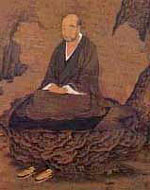Koso Wasan 42
Rivers of blind passions, on entering the ocean -
The great, compassionate Vow
Of unhindered light filling the ten quarters -
Become one in taste with that sea of wisdom.
Kleshas

The metaphor of a river is used in the Agamas. These are the sutras which coïncide with the Nikayas of the Pali Tripitaka. In the Sutra on the Log Shakyamuni tells us that we can consider life to be a river and that the way to live is to be so disposed as to be able to slip along the steam without being snared by the obstacles that can be found within and alongside the watercourse. In this verse the log is more carefully defined. Our personalities consist of the kleshas - here, 'evil passions'. The kleshas are those mental constituents that typify our condition of ignorance, darkness of mind (Sk. avidya). They are the things which characterise us as 'ordinary beings' (bombu, Sk., prthagjana). We are ordinary because we are ruled by our kleshas and are not wise; we have not transcended them and become exceptional; we have not become Buddhas. As long as we are beset with kleshas we are not Buddhas and we have not even attained the first stage of enlightenment.
The juxtaposition of kleshas and the 'water of wisdom' in this verse is quite deliberate and Shinran Shonin no doubt knew that it would have a strong impact upon his readers. How can it be possible for those factors (Sk., dharmas), which constitute and support our existence, to become 'one in taste with the water of wisdom'? The first thing to note is that Shinran does not suggest that the 'evil passions' are identical to the 'water of wisdom'. He tells us only that they are absorbed by the 'water of wisdom'. It is not that the old Mahayana adage - 'evil passion, as it is, is enlightenment' - means that there is some kind of blurring between distinct elements. This would be to suggest that an action (Sk. karma) motivated by an impulse arising from the kleshas, could be an enlightened action. I have often pointed out in these essays that, as I see it, some interpretations of the dharma from within the English-speaking world are somewhat lacking in rigour. T'an-luan uses the metaphor of weight when discussing the relative significance of the various factors of existence. Under the influence of enlightenment, the evil passions dissolve, as salt dissolves in water.
In my view we cannot read or chant these verses without reference to the Jodo Wasan. In the same way, we cannot read or study the Chapter on Faith in the Kyo Gyo Shin Sho without also reading the Chapter on True Buddha and Land. This is because in enjoying either T'an-luan or Shinran's perspective we need to have in mind the profoundly important significance within the Mahayana of the suchness - Tathata, which is ultimately the only existence, the only reality. While for the Sarvastivada sect of early Buddhism the dharmas are real, both primtive Buddha Dharma and the Mahayana regard them as genuinely evanescent.
Yet - let us make no mistake about it - the kleshas are more than 'real' from an every day point of view. They really do torment us. They tear us apart, make us fragmented. They are full of greed, anger and desire. They can be shocking and frightening in their intensity. They are like tectonic plates rupturing our calm and surging back and forth. They are the only 'reality' we know. One moment we are hurt, the next we are angry, then we are joyful, but suddenly embarrassed. We encounter someone who elicits feelings of revulsion but a few seconds later we meet a man or a woman who fills us with desire. We hear an opinion with which we give easy assent but the next moment someone says something that fills us with fury. These are the kleshas - in Japanese, bonno.
According to Shinran, as long as we live within the constraints of samsara the kleshes never leave us; internal conflict is something we cannot escape. People who claim to have found 'peace of mind' or to have become free of their kleshas are unusual because only Buddhas can make such a claim in any definitive way. In the way of nembutsu we cannot make such remarkable claims. In any case one's outward appearance and demeanour also changes, when one becomes a Buddha.
We need to refer back to the Jodo Wasan to understand again that the only arena which holds perfect sway is the 'land of infinite Light'. The light reaches and embraces us but it is the kleshas that hold sway in the context of our existence now. In the Buddhist scheme of things a powerful reality like suchness transforms all of its immediate environment. While the light that fills the ten quarters is unlimited, as long as kleshes hold sway in our realm - we are all interconnected and intertwined, mutually co-dependent - suffering will prevail. The truth is - and in the wasan we are on the cusp of this becoming a forceful theme - that our environment is not the Pure Land. The passions rule our experience and our existence almost to the exclusion of the dharma.
The 'rivers of evil passion' enter 'the water of wisdom' when they are overwhelmed by the light (wisdom) in the Land of Light - Sukhavati.